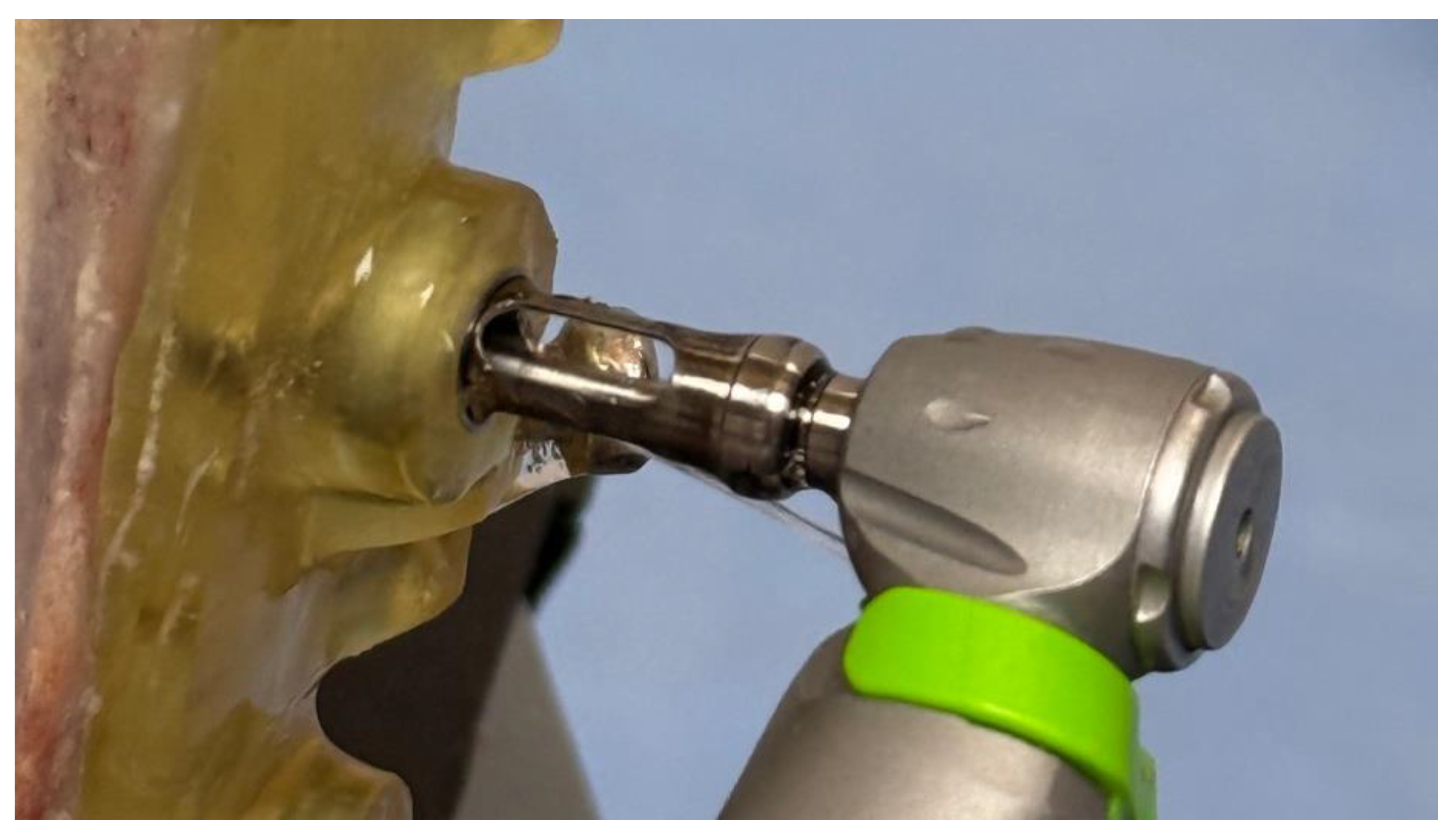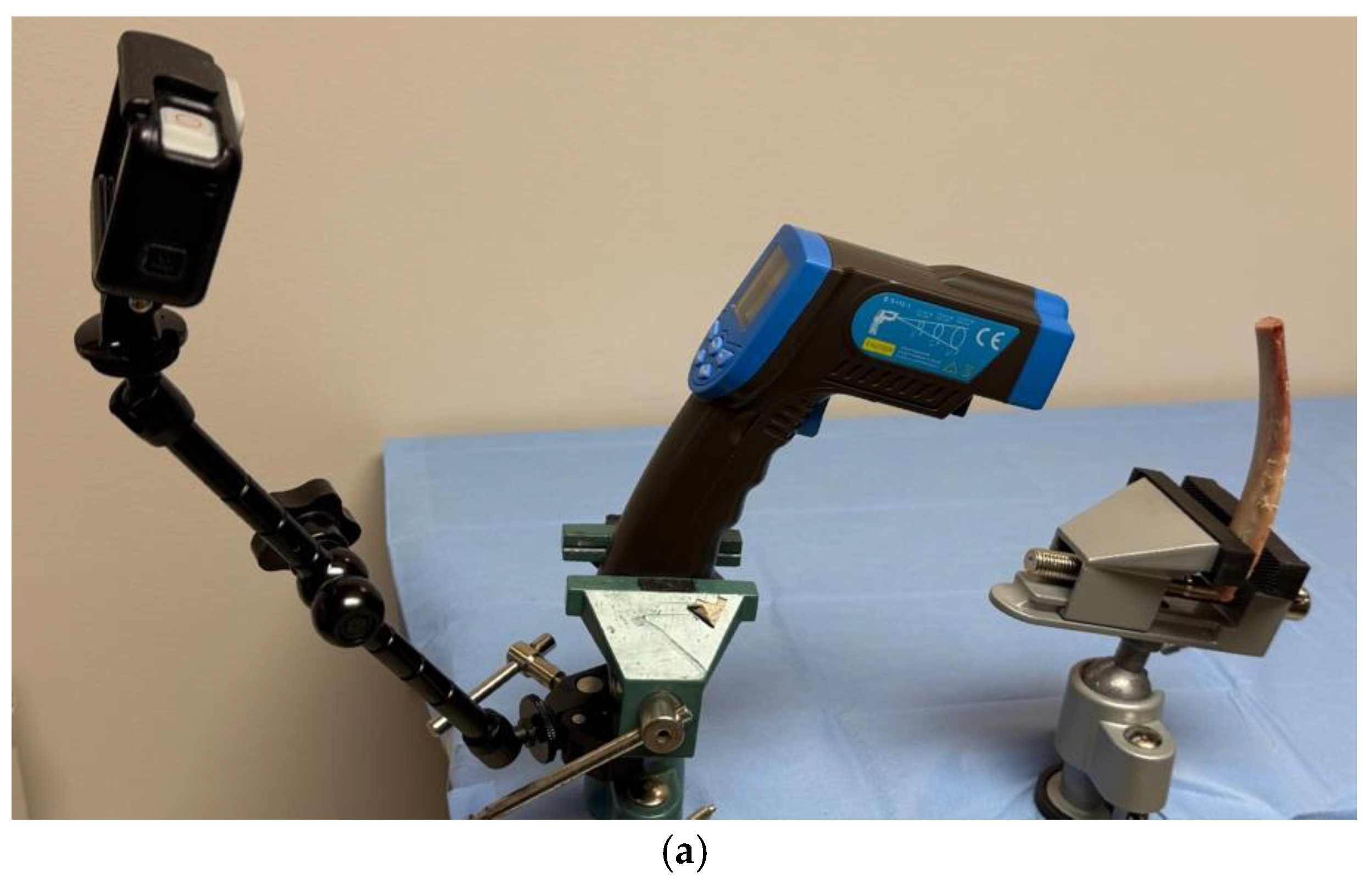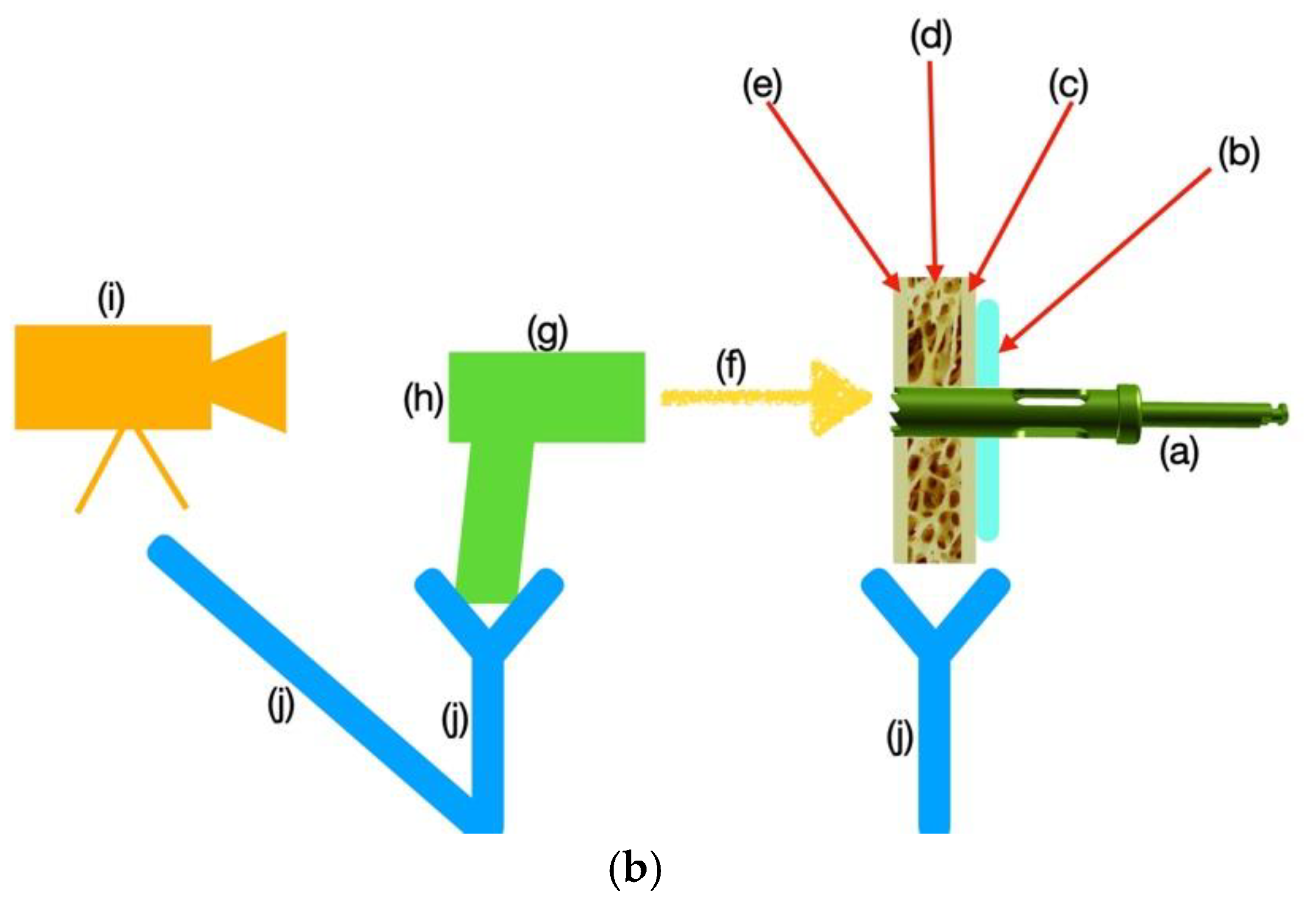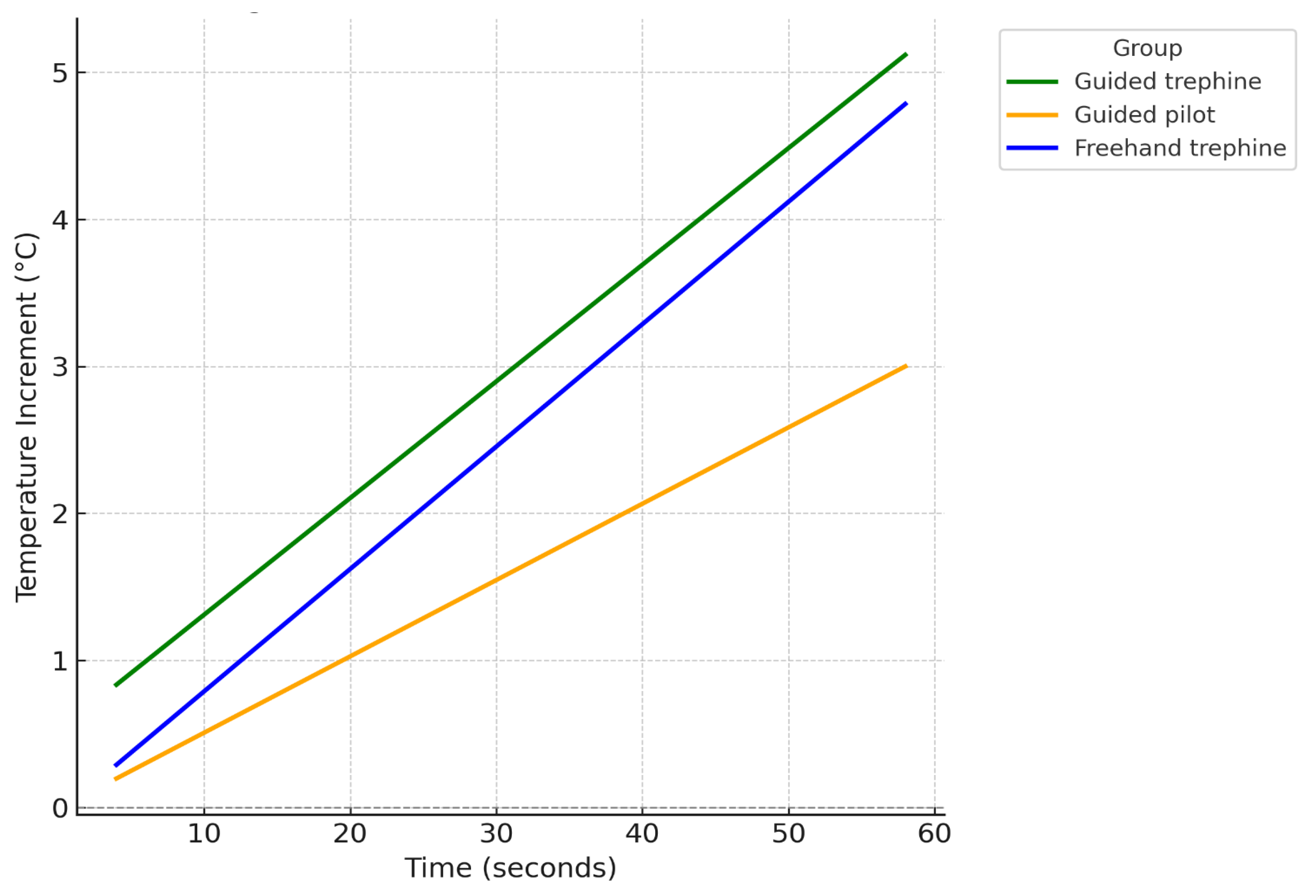Heat Generation During Guided Bone Drilling: Bone Trephine Versus Pilot Drill
Abstract
:1. Introduction
2. Materials and Methods
3. Statistical Analysis
4. Results
5. Discussion
6. Conclusions
- This study confirms that root apex removal with a trephine is both safe and effective, even when performed with static navigation.
- Our findings add to the existing literature on static navigation in endodontic surgery, specifically underscoring the safe use of custom trephines.
- Although the specialized endodontic trephine is safe, adequate irrigation and lubricant effects remain critical to control heat generation.
- Pre-cooling the irrigating solution can further reduce potential temperature spikes during drilling.
- Overall, careful planning and technique optimization are essential to maintain thermal safety in guided endodontic surgeries.
Author Contributions
Funding
Data Availability Statement
Conflicts of Interest
Abbreviations
| ANOVA | Analysis of variance |
| FHT | Freehand trephine |
| GT | Guided trephine |
| GP | Guided pilot |
References
- Eriksson, A.; Albrektsson, T.; Grane, B.; McQueen, D. Thermal injury to bone. A vital-microscopic description of heat effects. Int. J. Oral Surg. 1982, 11, 115–121. [Google Scholar] [CrossRef]
- Chacon, G.E.; Bower, D.L.; Larsen, P.E.; McGlumphy, E.A.; Beck, F.M. Heat production by 3 implant drill systems after repeated drilling and sterilization. J. Oral Maxillofac. Surg. 2006, 64, 265–269. [Google Scholar] [CrossRef] [PubMed]
- Trisi, P.; Berardini, M.; Falco, A.; Vulpiani, M.P. Effect of temperature on the dental implant osseointegration development in low-density bone: An in vivo histological evaluation. Implant Dent. 2015, 24, 96–100. [Google Scholar] [CrossRef] [PubMed]
- Trisi, P.; Berardini, M.; Falco, A.; Vulpiani, M.P.; Perfetti, G. Insufficient irrigation induces peri-implant bone resorption: An in vivo histologic analysis in sheep. Clin. Oral Implant. Res. 2014, 25, 696–701. [Google Scholar] [CrossRef]
- Möhlhenrich, S.; Modabber, A.; Steiner, T.; Mitchell, D.; Hölzle, F. Heat generation and drill wear during dental implant site preparation: Systematic review. Br. J. Oral Maxillofac. Surg. 2015, 53, 679–689. [Google Scholar] [CrossRef] [PubMed]
- Bachus, K.N.; Rondina, M.T.; Hutchinson, D.T. The effects of drilling force on cortical temperatures and their duration: An in vitro study. Med. Eng. Phys. 2000, 22, 685–691. [Google Scholar] [CrossRef]
- Cordioli, G.; Majzoub, Z. Heat generation during implant site preparation: An in vitro study. J. Oral Maxillofac. Implant. 1997, 12, 186–193. [Google Scholar]
- Boa, K.; Varga, E.; Pinter, G.; Csonka, A.; Gargyan, I. External cooling efficiently controls intraosseous temperature rise caused by drilling in a drilling guide system: An in vitro study. Br. J. Oral Maxillofac. Surg. 2015, 53, 963–967. [Google Scholar] [CrossRef]
- Yacker, M.J.; Klein, M. The effect of irrigation on osteotomy depth and bur diameter. Int. J. Oral Maxillofac. Implant. 1996, 11, 634–638. [Google Scholar]
- Liu, Y.; Wu, J.; Zhang, J.; Peng, W.; Liao, W. Numerical and Experimental Analyses on the Temperature Distribution in the Dental Implant Preparation Area when Using a Surgical Guide. J. Prosthodont. 2018, 27, 42–51. [Google Scholar] [CrossRef]
- dos Santos, P.L.; Pereira Queiroz, T.; Margonar, R.; de Souza Carvalho, A.C.G.; Betoni, W., Jr.; Rodrigues Rezende, R.R.; dos Santos, P.H.; Garcia, R., Jr. Evaluation of bone heating, drill deformation, and drill roughness after implant osteotomy: Guided surgery and classic drilling procedure. Int. J. Oral Maxillofac. Implants 2014, 29, 51–58. [Google Scholar] [CrossRef] [PubMed]
- Markovic, A.; Lazic, Z.; Misic, T.; Scepanovic, M.; Todorovic, A.; Thakare, K.; Janjic, B.; Vlahovic, Z.; Glisic, M. Effect of surgical drill guide and irrigans temperature on thermal bone changes during drilling implant sites—Thermographic analysis on bovine ribs. Vojn. Pregl. 2016, 73, 744–750. [Google Scholar] [CrossRef]
- Misir, A.F.; Sumer, M.; Yenisey, M.; Ergioglu, E. Effect of Surgical Drill Guide on Heat Generated From Implant Drilling. J. Oral Maxillofac. Surg. 2009, 67, 2663–2668. [Google Scholar] [CrossRef]
- Smith, B.G.; Pratt, A.M.; Anderson, J.A.; Ray, J.J. Targeted Endodontic Microsurgery: Implications of the Greater Palatine Artery. J. Endod. 2021, 47, 19–27. [Google Scholar] [CrossRef] [PubMed]
- Giacomino, C.M.; Ray, J.J.; Wealleans, J.A. Targeted Endodontic Microsurgery: A Novel Approach to Anatomically Challenging Scenarios Using 3-dimensional–printed Guides and Trephine Burs—A Report of 3 Cases. J. Endod. 2018, 44, 671–677. [Google Scholar] [CrossRef] [PubMed]
- Zhao, D.; Xie, W.; Li, T.; Wang, A.; Wu, L.; Kang, W.; Wang, L.; Guo, S.; Tang, X.; Xie, S. New-designed 3D printed surgical guide promotes the accuracy of endodontic microsurgery: A study of 14 upper anterior teeth. Sci. Rep. 2023, 13, 1–8. [Google Scholar] [CrossRef]
- Antal, M.; Nagy, E.; Braunitzer, G.; Fráter, M.; Piffkó, J. Accuracy and clinical safety of guided root end resection with a trephine: A case series. Head Face Med. 2019, 15, 1–8. [Google Scholar] [CrossRef]
- Nagy, E.; Fráter, M.; Antal, M. Guided modern endodontic microsurgery by use of a trephine bur. Orv. Hetil. 2020, 161, 1260–1265. [Google Scholar] [CrossRef]
- Antal, M.; Nagy, E.; Sanyó, L.; Braunitzer, G. Digitally planned root end surgery with static guide and custom trephine burs: A case report. Int. J. Med. Robot. Comput. Assist. Surg. 2020, 16, e2115. [Google Scholar] [CrossRef]
- Nagy, E.; Braunitzer, G.; Gryschka, D.G.; Barrak, I.; Antal, M.A. Accuracy of digitally planned, guided apicoectomy with a conventional trephine and a custom-made endodontic trephine: An in vitro comparative study. J. Stomatol. Oral Maxillofac. Surg. 2022, 123, 388–394. [Google Scholar] [CrossRef]
- Kiscsatári, R.; Nagy, E.; Szabó, M.; Braunitzer, G.; Piffkó, J.; Fráter, M.; Antal, M.Á. Comparison of the Three-Dimensional Accuracy of Guided Apicoectomy Performed with a Drill or a Trephine: An In Vitro Study. Appl. Sci. 2023, 13, 9642. [Google Scholar] [CrossRef]
- Omar, S.; Jaiswal, H.; Mishra, S.; Bhargava, D.; Kumar, P. A comparative study to evaluate the heat generated during osteotomy with conventional drill, trephine and alveolar expander. Eur. Oral Res. 2023, 57, 22–27. [Google Scholar] [CrossRef] [PubMed]
- Barrak, I.; Joób-Fancsaly, Á.; Braunitzer, G.; Varga, E., Jr.; Boa, K.; Piffkó, J. Intraosseous Heat Generation During Osteotomy Performed Freehand and Through Template With an Integrated Metal Guide Sleeve: An In Vitro Study. Implant Dent. 2018, 27, 342–350. [Google Scholar] [CrossRef]
- Boa, K.; Barrak, I.; Varga, E.; Joob-Fancsaly, A.; Piffko, J. Intraosseous generation of heat during guided surgical drilling: An ex vivo study of the effect of the temperature of the irrigating fluid. Br. J. Oral Maxillofac. Surg. 2016, 54, 904–908. [Google Scholar] [CrossRef] [PubMed]
- Gupta, S.; Gupta, A.S.; Chandu, G.S.; Jain, S. Infrared thermographic evaluation of rise in temperature with conventional versus trephine drills. J. Indian Prosthodont. Soc. 2021, 21, 45–49. [Google Scholar] [CrossRef]
- Bhargava, N.; Perrotti, V.; Caponio VC, A.; Matsubara, V.H.; Patalwala, D.; Quaranta, A. Comparison of heat production and bone architecture changes in the implant site preparation with compressive osteotomes, osseodensification technique, piezoelectric devices, and standard drills: An ex vivo study on porcine ribs. Odontology 2023, 111, 142–153. [Google Scholar] [CrossRef]
- Antonelli, A.; Barone, S.; Attanasio, F.; Salviati, M.; Cerra, M.G.; Calabria, E.; Bennardo, F.; Giudice, A. Effect of Implant Macro-Design and Magnetodynamic Surgical Preparation on Primary Implant Stability: An In Vitro Investigation. Dent. J. 2023, 11, 227. [Google Scholar] [CrossRef] [PubMed]
- Kim, S.J.; Yoo, J.; Kim, Y.S.; Shin, S.W. Temperature change in pig rib bone during implant site preparation by low-speed drilling. J. Appl. Oral Sci. 2010, 18, 522–527. [Google Scholar] [CrossRef]
- Niehues, S.M.; Elezkurtaj, S.; Bresssem, K.K.; Hamm, B.; Erxleben, C.; Vahldiek, J.; Adams, L.C. Evaluation of potential tissue heating during percutaneous drill-assisted bone sampling in an in vivo porcine study. Skelet. Radiol. 2022, 51, 829–836. [Google Scholar] [CrossRef]
- Gurdán, Z.; Vajta, L.; Tóth, Á.; Lempel, E.; Joób-Fancsaly, Á.; Szalma, J. Effect of pre-drilling on intraosseous temperature during self-drilling mini-implant placement in a porcine mandible model. J. Oral Sci. 2017, 59, 47–53. [Google Scholar] [CrossRef]
- Aerssens, J.; Boonen, S.; Lowet, G.; Dequeker, J. Interspecies differences in bone composition, density, and quality: Potential implications for in vivo bone research. Endocrinology 1998, 139, 663–670. [Google Scholar] [CrossRef] [PubMed]
- Lunney, J.K.; Van Goor, A.; Walker, K.E.; Hailstock, T.; Franklin, J.; Dai, C. Importance of the pig as a human biomedical model. Sci. Transl. Med. 2021, 13, eabd5758. [Google Scholar] [CrossRef]
- Katranji, A.; Misch, K.; Wang, H.L. Cortical bone thickness in dentate and edentulous human cadavers. J. Periodontol. 2007, 78, 874–878. [Google Scholar] [CrossRef]
- Sener, B.C.; Dergin, G.; Gursoy, B.; Kelesoglu, E.; Slih, I. Effects of irrigation temperature on heat control in vitro at different drilling depths. Clin. Oral Implants Res. 2009, 20, 294–298. [Google Scholar] [CrossRef] [PubMed]
- Augustin, G.; Davila, S.; Udiljak, T.; Vedrina, D.S.; Bagatin, D. Determination of spatial distribution of increase in bone temperature during drilling by infrared thermography: Preliminary report. Arch. Orthop. Trauma. Surg. 2009, 129, 703–709. [Google Scholar] [CrossRef]
- Stelzle, F.; Frenkel, C.; Riemann, M.; Knipfer, C.; Stockmann, P.; Nkenke, E. The effect of load on heat production, thermal effects and expenditure of time during implant site preparation—An experimental ex vivo comparison between piezosurgery and conventional drilling. Clin. Oral Implants Res. 2014, 25, e140–e148. [Google Scholar] [CrossRef] [PubMed]
- Sedlin, E.D.; Hirsch, C. Factors affecting the determination of the physical properties of femoral cortical bone. Acta Orthop. Scand. 1966, 37, 29–48. [Google Scholar] [CrossRef]
- Bhargava, D.; Thomas, S.; Pandey, A.; Deshpande, A.; Mishra, S.K. Comparative study to evaluate bone loss during osteotomy using standard drill, bone trephine, and alveolar expanders for implant placement. J. Indian Prosthodont. Soc. 2018, 18, 226–230. [Google Scholar]
- Barrak, I.; Boa, K.; Joob-Fancsaly, A.; Varga, E.; Sculean, A.; Piffko, J. Heat Generation During Guided and Freehand Implant Site Preparation at Drilling Speeds of 1500 and 2000 RPM at Different Irrigation Temperatures: An In Vitro Study. Oral Health Prev. Dent. 2019, 17, 309–316. [Google Scholar] [CrossRef]
- Varga, E., Jr.; Antal, M.; Major, L.; Kiscsatári, R.; Braunitzer, G.; Piffkó, J. Guidance means accuracy: A randomized clinical trial on freehand versus guided dental implantation. Clin. Oral Implants Res. 2020, 31, 417–430. [Google Scholar] [CrossRef]
- Chakraborty, S.; Moufti, M.A.; Kheder, W. The Effect of Dental Implant Drills Materials on Heat Generation in Osteotomy Sites: A Systematic Review. Eur. J. Dent. 2024, 18, 65–72. [Google Scholar] [CrossRef] [PubMed]
- Migliorati, M.; Amorfini, L.; Signori, A.; Barberis, F.; Silvestrini Biavati, A.; Benedicenti, S. Internal bone temperature change during guided surgery preparations for dental implants: An in vitro study. Int. J. Oral Maxillofac. Implants 2013, 28, 1464–1469. [Google Scholar] [CrossRef]
- Koopaie, M.; Kolahdouz, S.; Kolahdouz, E.M. Comparison of wear and temperature of zirconia and tungsten carbide tools in drilling bone: In vitro and finite element analysis. Br. J. Oral Maxillofac. Surg. 2019, 57, 557–565. [Google Scholar] [CrossRef] [PubMed]
- Scarano, A.; Lorusso, F.; Noumbissi, S. Infrared Thermographic Evaluation of Temperature Modifications Induced during Implant Site Preparation with Steel vs. Zirconia Implant Drill. J. Clin. Med. 2020, 9, 148. [Google Scholar] [CrossRef]
- Sumer, M.; Keskiner, I.; Mercan, U.; Misir, F.; Cankaya, S. Assessment of heat generation during implant insertion. J. Prosthet. Dent. 2014, 112, 522–525. [Google Scholar] [CrossRef] [PubMed]
- Harder, S.; Egert, C.; Freitag-Wolf, S.; Mehl, C.; Kern, M. Intraosseous Temperature Changes During Implant Site Preparation: In Vitro Comparison of Thermocouples and Infrared Thermography. Int. J. Oral Maxillofac. Implants 2018, 33, 72–78. [Google Scholar] [CrossRef] [PubMed]
- Aldabagh, A.; Sultan, A. Effect of Cooling an Irrigation Solution During Preparation of Implant Site on Heat Generation Using Elite System for implant. (Experimental Study). Al-Rafidain Dent. J. 2009, 10, 260–264. [Google Scholar] [CrossRef]








| Parameter | Freehand Trephine (FHT) | Guided Pilot (GP) | Guided Trephine (GT) |
|---|---|---|---|
| Initial temperature (°C(±SD)) | 22.63 (±1.39) | 22.98 (±1.35) | 21.82 (±1.15) |
| Mean temperature change to cortical 1 (°C(±SD)) | 1.37 (±1.54) | 0.36 (±0.25) | 1.22 (±1.04) |
| Time to cortical 1 penetration (s(±SD)) | 17.75 (±8.29) | 8.50 (±1.45) | 20.08 (±10.31) |
| Mean temperature change to cortical 2 (°C(±SD)) | 2.88 (±1.54) | 0.72 (±0.3) | 3.82 (±1.77) |
| Time to cortical 2 penetration (total time) (s(±SD)) | 34.25 (±11.64) | 12.75 (±1.54) | 30.33 (±13.85) |
| Mean temperature change to peak (°C(±SD)) | 3.25 (±1.9) | 0.74 (±0.31) | 4.5 (±2.44) |
Disclaimer/Publisher’s Note: The statements, opinions and data contained in all publications are solely those of the individual author(s) and contributor(s) and not of MDPI and/or the editor(s). MDPI and/or the editor(s) disclaim responsibility for any injury to people or property resulting from any ideas, methods, instructions or products referred to in the content. |
© 2025 by the authors. Licensee MDPI, Basel, Switzerland. This article is an open access article distributed under the terms and conditions of the Creative Commons Attribution (CC BY) license (https://creativecommons.org/licenses/by/4.0/).
Share and Cite
Pintér, G.; Braunitzer, G.; Nagy, E.; Boa, K.; Piffkó, J.; Antal, M.A. Heat Generation During Guided Bone Drilling: Bone Trephine Versus Pilot Drill. Lubricants 2025, 13, 115. https://doi.org/10.3390/lubricants13030115
Pintér G, Braunitzer G, Nagy E, Boa K, Piffkó J, Antal MA. Heat Generation During Guided Bone Drilling: Bone Trephine Versus Pilot Drill. Lubricants. 2025; 13(3):115. https://doi.org/10.3390/lubricants13030115
Chicago/Turabian StylePintér, Gábor, Gábor Braunitzer, Eszter Nagy, Kristóf Boa, József Piffkó, and Mark Adam Antal. 2025. "Heat Generation During Guided Bone Drilling: Bone Trephine Versus Pilot Drill" Lubricants 13, no. 3: 115. https://doi.org/10.3390/lubricants13030115
APA StylePintér, G., Braunitzer, G., Nagy, E., Boa, K., Piffkó, J., & Antal, M. A. (2025). Heat Generation During Guided Bone Drilling: Bone Trephine Versus Pilot Drill. Lubricants, 13(3), 115. https://doi.org/10.3390/lubricants13030115






